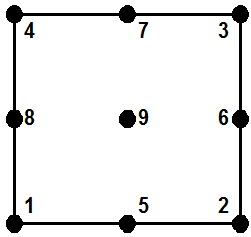Nine Four Node Quad u-p Element: Difference between revisions
No edit summary |
No edit summary |
||
| Line 59: | Line 59: | ||
|} | |} | ||
Code Developed by: <span style="color:blue"> UC San Diego (Dr. Zhaohui Yang)</span>: | |||
---- | ---- | ||
UC San Diego Soil Model: | |||
{{UCSDUpElementsMenu}} | {{UCSDUpElementsMenu}} | ||
Revision as of 00:14, 10 August 2012
- Command_Manual
- Tcl Commands
- Modeling_Commands
- model
- uniaxialMaterial
- ndMaterial
- frictionModel
- section
- geometricTransf
- element
- node
- sp commands
- mp commands
- timeSeries
- pattern
- mass
- block commands
- region
- rayleigh
- Analysis Commands
- Output Commands
- Misc Commands
- DataBase Commands
Nine_Four_Node_QuadUP is a 9-node quadrilateral plane-strain element. The four corner nodes have 3 degrees-of-freedom (DOF) each: DOF 1 and 2 for solid displacement (u) and DOF 3 for fluid pressure (p). The other five nodes have 2 DOFs each for solid displacement. This element is implemented for simulating dynamic response of solid-fluid fully coupled material, based on Biot's theory of porous medium.
Please click here for examples.
OUTPUT INTERFACE:
Pore pressure can be recorded at an element node using OpenSees Node Recorder:
recorder Node <-file $fileName> <-time> <-node ($nod1 $nod2 …)> -dof 3 vel
See OpenSees command manual (McKenna and Fenves 2001) for nodal displacement, velocity, or acceleration recorders.
The valid queries to a Nine_Four_Node_QuadUP element when creating an ElementRecorder are 'force', 'stiffness', or 'material matNum matArg1 matArg2 ...', where matNum represents the material object at the corresponding integration point.
| element 9_4_QuadUP $eleTag $Node1 $Node2 $Node3 $Node4 $Node5 $Node6 $Node7 $Node8 $Node9 $thick $matTag $bulk $fmass $hPerm $vPerm <$b1=0 $b2=0> |
| $eleTag | A positive integer uniquely identifying the element among all elements |
| $Node1,… $Node9 | Nine element node (previously defined) numbers (see figure above for order of numbering). |
| $thick | Element thickness |
| $matTag | Tag of an NDMaterial object (previously defined) of which the element is composed |
| $bulk | Combined undrained bulk modulus Bc relating changes in pore pressure and volumetric strain, may be approximated by:
Bc ≈ Bf/n where Bf is the bulk modulus of fluid phase (2.2x106 kPa (or 3.191x105 psi) for water), and n the initial porosity. |
| $fmass | Fluid mass density |
| $hPerm, $vPerm | Permeability coefficient in horizontal and vertical directions respectively. |
| $b1, $b2 | Optional gravity acceleration components in horizontal and vertical directions respectively (defaults are 0.0) |
Code Developed by: UC San Diego (Dr. Zhaohui Yang):
UC San Diego Soil Model:
- Element Command
- UC San Diego u-p element (saturated soil)
- NDMaterial Command
- UC San Diego soil models (Linear/Nonlinear, dry/drained/undrained soil response under general 2D/3D static/cyclic loading conditions (please visit UCSD for examples)
- UC San Diego Saturated Undrained soil
- Related References
